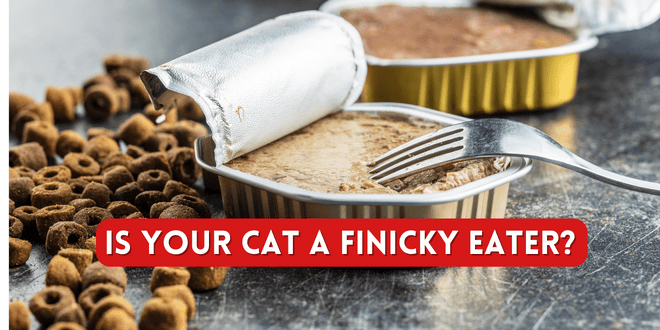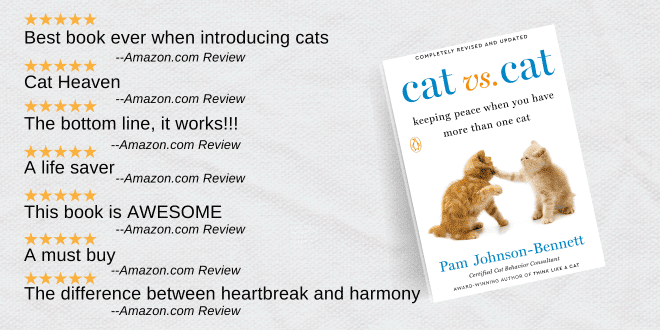
We’ve discussed cat feeding habits in several other posts, and we’ve all heard cats referred to as finicky eaters. You might even be living with one yourself. No matter what food you bring home from the store your cat just turns their her nose up at it and gives you a look that says is that the best you have to offer? In reality though, finicky eaters are made and not born. Here are a few tips:
Visit the Veterinarian
If your cat has developed a change in appetite, the first thing that should be done is to have a veterinary check-up to make sure there isn’t an underlying medical cause for the sudden change. If your cat has stopped eating altogether, a veterinary visit is of the utmost importance because if she goes more than a couple of days without eating she is at risk for developing hepatic lipidosis. This is a condition where fatty deposits accumulate in the liver and it’s a very serious problem.
Have You Changed Your Cat’s Food?
One of the most common reasons a cat develops finicky eating syndrome has to do with the cat parent making sudden changes in the food. While variety is very helpful in avoiding fixed food preferences, abrupt changes can be upsetting to the digestive system. It’s good to introduce different brands/flavors and rotate them but make sure you do a gradual transition each time you introduce an unfamiliar food. Gradually add a little of the new food into the current brand over the course of a few days. Once that food becomes familiar you can then include that in your meal rotation.
Feeding Your Cat Table Scraps
Another reason finicky eating can occur is due to the feeding of table scraps. Why in the world would a cat want to eat her bowl of boring cat food or dry kibble after sampling some fried chicken, grilled salmon or even a nibble of filet mignon? Supplementing your cat’s diet with rich foods with high taste appeal is a sure way to get her to turn that cute little nose up at her regular meal offering. What often happens at that point is the cat parent starts incorporating some table scraps into the cat’s regular food in an attempt to get her to eat. This upsets the nutritional balance. And, because your cat is very smart, she quickly learns to simply eat around the cat food to get at the tasty table scraps.
Food Bowl Conditions
Finicky eating can also be the result of the conditions surrounding the feeding station. If you merely add more food into an already dirty bowl it can discourage your cat from eating. Be sure to wash the food and water bowl daily. If you feed wet food to your cat, take the food up after 20-30 minutes so it doesn’t dry out and turn to cement.
A cat may also become finicky about meals if the bowl creates discomfort or makes her feel vulnerable. Many cats don’t like the discomfort of having their whiskers squished when eating, due to a small, deep food bowl. In a multicat home, a cat who has to lower her head far down into the food bowl may not feel comfortable because she won’t be able to see what’s happening in the environment around her. This can be a problem in a household where there is multicat tension or any other situation where a cat may feel vulnerable. Choose food/water bowls that are shallow for maximum whisker comfort and to allow the cat to visually monitor the room while eating.
Food Temperature
Food served directly from the refrigerator is very unappealing. Cats rely on their noses to tell them whether food is fresh before they will eat. Cold food has little scent so a cat may reject it. Cold food can also be upsetting to the stomach. On the other hand, be careful when heating food as well. Food served too hot may cause a cat to reject it, especially if she has burned her tongue or mouth from a too-hot meal previously. If you microwave cold food, stir it to avoid having hot spots in the food. Don’t overheat food as well because it destroys the taste and the nutrients.
Stressful Kitty = Unhappy Kitty
Stress can also play a factor in finicky eating. Make sure the feeding station is a safe and secure place for your cat. In a multicat environment you may need to set up more than one feeding station if one cat overpowers another in an attempt to claim all the food. The feeding station needs to be a place where a cat feels secure. If your cat is nervous or afraid of being ambushed by a companion cat, dog or even the children, it can affect appetite. Many cats don’t enjoy eating so close together, even in households where cats get along at other times of the day. Create an environment where mealtime is peaceful.
Need More Information?
If you need more information about cat behavior and training, refer to the best-selling books by Pam Johnson-Bennett. Pam’s books are available at bookstores everywhere and online. We’ve included Amazon links here on our website.
If you have a question regarding your cat’s health, please contact your veterinarian. This article is not intended as a replacement for your cat’s veterinary care. This article is for information purposes only and not offering medical advice or providing a medical diagnosis.




